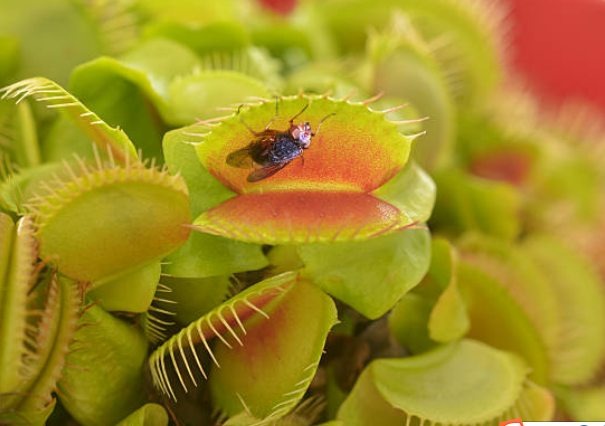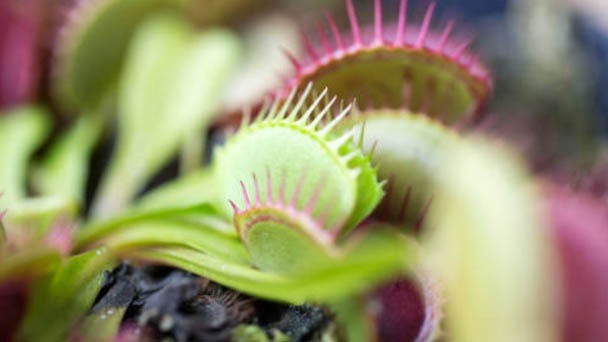Perennial carnivorous plants called venus flytraps have a 20-year lifespan in the wild. Insects provide nutrients that aren't easily accessible in the soil, despite the fact that most of their energy comes from photosynthesis.
One must delve a little deeper to discover the lifespan of venus flytraps. Learn more about their lifespans and how to prolong the life of your Venus flytrap by reading the information below.
How Long Do Venus Fly Traps Live?
Typically, venus flytraps live for 20 to 24 years. They are perennial plants as a result. From seedling to fully grown plant, they take between three and five years. Experts can grow a mature plant in a greenhouse in two to three years. Once the plant reaches maturity, venus flytraps only produce one bloom per year, which occurs in the spring. (Read More: How to Grow Venus Flytraps from Seed)
In winters, at temperatures below 45 degrees F, the plant undergoes dormancy which ends with the onset of the spring. The plant's metabolism slows to a crawl during the dormancy period, and it does not grow.
What is a Venus Flytrap?
Venus flytrap (Dionaea muscipula) is a plant in the family Droseraceae which contains all carnivorous plants meaning they feed on animals. 180 species of carnivorous plants in three genera make up the family Droseraceae. It is fascinating to observe how the noble plants that we have always believed to be harmless to all other species turned carnivorous. Like all other plant species, these are a green color. Through photosynthesis and from the roots, they get their nutrition. Because of this, they have evolved to take nitrogen from animals. They grow in soils that are deficient in nutrients, especially nitrogen. Let's examine in greater detail the Venus flytrap's carnivorous behavior.
Venus Flytrap Habitat
The marshes surrounding Wilmington, North Carolina, and a small portion of South Carolina are home to the native Venus flytrap, which is only found there. It thrives in the open understory's nutrient-poor, moist, acidic soils. Burning bushes and shrubs promotes the growth of an open understory. New Jersey and Florida are now the locations of the plant. Additionally, it is grown and offered to regular people in retail form. But because of habitat loss brought on by fire suppression, pine monoculture, etc., its wild population is in danger. More sunlight and humid environments are ideal for Venus flytrap growth.
How Do Venus Flytraps Work?
The trap of the Venus flytrap frequently turns red and has a fruity scent. Venus flytraps are a bug magnet due to their colorful combination and delightful scent. The inner surface contains stiff hair.
A signal can be sent across the Flytrap's body if a fly bumps into it. The plant is programmed to wait because there are only a certain number of traps per trap, preventing it from closing shut in response to erroneous signals.
The trapped fly has to touch the hair once more in the following 20 seconds. If this occurs, another signal is sent down the Venus Flytrap's body, and it closes. A fly is restrained. Digestive enzymes are created by the flytrap between the third and fifth time a fly touches its hair.
The fly asphyxiates after a few hours when the air in the trap runs out. Having done this, the fluid in the trap starts to become acidic and start to digest the fly's body.
The nutrients that have been digested are also absorbed by the trap. It might take a while. In order to track and complete digestion, the Venus flytrap has a very effective mechanism. It thrives in swamps and other environments with low nutrient sources as a result.
You can read an article I wrote about the venus flytrap's operation by clicking the link below if you'd like to know more about how it functions inside.

How Else Does the Venus Flytrap Gain Nutrition?
Although it is well-known that this plant gets its nutrition from catching flies, it also gets it from other sources. The plant does obtain nutrition through the assimilation of nutrients from the soil. It uses photosynthesis, like the majority of other green plants, to obtain its energy from the sun.
Insects like ants, spiders, and flies, among others, are also trapped in addition to this in order to obtain food. In order to survive in harsh environments where it is impossible to obtain all of one's nutritional needs through traditional means, these must be digested.
Technically, a venus flytrap doesn't need to catch insects to survive. They can survive on a healthy amount of sunlight. In reality, their primary source of nutrition is the sun. The sun is necessary for them to grow strong, to put it another way. They compare the bugs to their fertilizer. It is similar to receiving a regular dose of fertilizer if they catch a few here and there. (Read More: Venus Fly Trap Light Requirements - Does It Need Direct Sunlight?)
Under What Conditions Do Venus Flytraps Live?
Venus flytraps typically exist in particular types of environments. Areas along the coast are typically among them. The understory—a collection of canopies beneath the main canopy—exists in coastal forests. The Venus Flytrap has digestive systems to survive in these dimly lit areas. They frequently grow in acidic, wet soil that is deficient in nutrients. Additionally, fires that burn frequently in the areas where they grow deplete the soil's nitrogen.
The Venus Flytrap can still obtain its nutrients from the insects they ingest despite these circumstances. This is how they manage to thrive in these trying circumstances with only moderate sunlight.
You might be interested in learning how long wild Venus flytraps live. In their natural environment, they typically love for about 20 years, as was previously mentioned. The fact that these plants can survive underwater for a few months is also interesting. That was a fact that I found to be extremely shocking! What a courageous and amazing strategy.
Can Venus Flytraps Live Indoors?
Venus flytraps do, in fact, reside inside. For as long as they can survive in their natural habitats, they can survive in these circumstances. If you intend to grow one, you should give it plenty of direct sunlight or invest in a grow light bulb.
Use a soil that contains silica sand, perlite, and peat moss. The plant will continue to thrive with the help of the sun and well-aerated soil mixture. Place the plant outside if at all possible so that insects can interact with it. While it is not necessary to catch insects, doing so is a great way to fertilize your venus flytrap. Both will contribute to the longevity and strength of your venus flytrap.
Can Venus Flytraps Live Without Water?
Venus flytraps can indeed survive without water. Depending on the season, they might last for around four weeks. They need more water than usual in the summer. In general, you should keep a cm of water under the Venus flytrap during the summer. Although the venus flytrap doesn't need to be submerged in water, it might come in handy if you tend to forget to water your plant.
For the Venus Flytrap to grow well, the water must be sufficiently moist without being waterlogged. It is also best to avoid using filtered water on this plant. Use reverse osmosis water, distilled water, or water that has been collected from the rain instead.
Do Insects Affect How Long a Venus Flytrap Lives?
The quantity of insects a venus flytrap manages to capture can also affect how long it survives. Venus flytraps must generally be kept free of any bacteria and fungi. For them to grow and live a long time, this is crucial.
An insect that is larger than the Venus flytrap's trap may occasionally be caught in it. If the trap closes, a portion of it hangs outside while the remaining portion is embedded inside the trap. As a result, the trap may become contaminated with bacteria and fungi that are present on the insect's exoskeleton. If the situation persists, the trap may eventually rot and fall off due to fungal growth.
Other fungi species may also have an impact on the plant. As a result, it is wise to periodically check your plant for fungi. Before the plant is harmed, you might want to clean up any that you notice.
Use a medium-sized insect in relation to the size of the trap if you are feeding the plant yourself. Aim to keep the insect's size to no more than 1/3 of the trap's size. Prior to letting it sit while you wait for the trap to close, squeeze it and move it around the Venus Flytrap's hair a few times. This will guarantee that the trap closes and that the insect is completely contained inside of it. To release the enzymes that will break down the insect, the trap needs a secondary trigger.
From what we've seen so far, the Venus flytrap has a wild lifespan of 20 to 24 years. It can also live as long in domestic settings if properly cared for. Do not forget that how you care for your venus flytrap will determine how long it lives. You can keep your venus flytrap alive for a very long time by understanding its special requirements and ideal growing conditions!
Generally speaking, it's crucial to ensure that the Flytrap has conditions that include moist soil and lots of sunlight during the summer. It is most likely to go dormant during the winter. During this time, you might want to move it out of the sun.
Read More About Venus Flytraps

